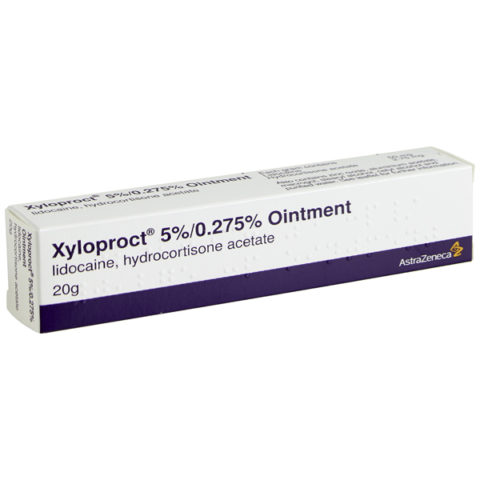Xyloproct Ointment (20g)
£24.49
- Helps Relieve Haemorrhoids
- Active Ingredients: Hydrocortisone / Lidocaine
- Includes Free Prescription
- Buy Online With Confidence From UK Registered Pharmacy
Xyloproct Ointment may be used in adults to relieve itching around the back passage (anus) or female private parts (genitals) and to relieve the symptoms of piles (haemorrhoids) and other problems that affect the back passage. These symptoms include pain and inflammation.
Click Here To Complete Consultation
In stock

Discreet Packaging

UK Based
-
What Xyloproct Ointment is and what it is used for
What Xyloproct Ointment is
The name of your medicine is ‘Xyloproct 5%/0.275% Ointment’. It is referred to as ‘Xyloproct Ointment’ in the rest of this leaflet. Xyloproct Ointment contains two medicines: lidocaine and hydrocortisone.- Lidocaine (sometimes known as lignocaine) belongs to a group of medicines called local anaesthetics.
- Hydrocortisone belongs to a group of medicines called corticosteroids.
See more on Haemorrhoids.What Xyloproct Ointment is used for
Xyloproct Ointment may be used in adults for the following reasons:- to relieve itching around the back passage (anus) or female private parts (genitals).
- to relieve the symptoms of piles (haemorrhoids) and other problems that affect the back passage. These symptoms include pain and inflammation.
Before you use Xyloproct Ointment
Do not use Xyloproct Ointment:
- if you are allergic to lidocaine or hydrocortisone or any of the other ingredients of this medicine (listed in section 6).
- if you have ever had an allergic reaction to other local anaesthetics or to other corticosteroid medicines.
- if you have an infection where the ointment is going to be put and the infection is not being treated.
- if you are not in hospital and you are taking medicines for an uneven heart beat (such as amiodarone or sotalol).
How to use Xyloproct Ointment
Always use Xyloproct Ointment exactly as your doctor has told you. Check with your doctor or pharmacist if you are not sure. Always wash your hands well before and after using this medicine.How much Xyloproct Ointment to use
- Your doctor will tell you how much ointment to use and how often to use it.
- Usually the ointment should be put on the affected area several times a day.
- Up to 6 g (grams) of ointment can be used each day. This is about a third of a tube.
How long to use Xyloproct Ointment for
- Xyloproct Ointment should only be used for limited periods of time.
- With longer periods of treatment (up to 3 weeks) your doctor may suggest that you have a break from treatment, especially if you are getting irritation around or inside where the ointment is applied.
- If you get irritation, your doctor may do a patch test to see if it is being caused by Xyloproct Ointment.
Using the applicator
- The ointment comes with an applicator. Your doctor will tell you if you need to use this.
- If your doctor tells you to use the applicator, be careful not to put too much ointment inside the back passage, especially if it is being given to a child.
- Clean the applicator very well after each use.
If you have any further questions on the use of this medicine, ask your doctor or pharmacist.If you use more Xyloproct Ointment than you should
- If you use too much ointment talk to your doctor as soon as possible.
- It is particularly important to talk to your doctor as soon as possible if a child has been given too much ointment. This is because fits have sometimes happened in children who have been given too much.
Xyloproct Ingredients
The active substances are lidocaine and hydrocortisone acetate. Each gram of Xyloproct Ointment contains 50 mg (milligrams) of lidocaine and 2.75 mg of hydrocortisone acetate. The other ingredients are zinc oxide, aluminium acetate, stearyl alcohol, cetyl alcohol, purified water and macrogol (3350 and 400). See our other Hemorrhoid Treatments -
Piles (haemorrhoids)
Piles (haemorrhoids) are lumps inside and around your bottom (anus). They often get better on their own after a few days. There are things you can do to treat and prevent piles.
Symptoms of piles include:
-bright red blood after you poo
-an itchy anus
-feeling like you still need to poo after going to the toilet
-slimy mucus in your underwear or on toilet paper after wiping your bottom
-lumps around your anus
-pain around your anusHow you can treat or prevent piles
Do
-drink lots of fluid and eat plenty of fibre to keep your poo soft
-wipe your bottom with damp toilet paper
-take paracetamol if piles hurt
-take a warm bath to ease itching and pain
-use an ice pack wrapped in a towel to ease discomfort
-gently push a pile back inside
-keep your bottom clean and dry
-exercise regularly
-cut down on alcohol and caffeine (like tea, coffee and cola) to avoid constipationDon’t
-do not wipe your bottom too hard after you poo
-do not ignore the urge to poo
-do not push too hard when pooing
-do not take painkillers that contain codeine, because they cause constipation
-do not take ibuprofen if your piles are bleeding
-do not spend more time than you need to on the toiletNon-urgent advice: See a GP if:
there’s no improvement after 7 days of treatment at home
you keep getting piles
Your GP may prescribe stronger medicines for haemorrhoids or constipation.What causes piles?
Piles are swollen blood vessels. It’s not clear what causes them.
Things that make piles more likely:
constipation
pushing too hard when pooing
pregnancy – read about piles during pregnancy
heavy lifting -
Side Effects
Like all medicines, this medicine can cause side effects, although not everybody gets them.
Stop using Xyloproct Ointment and talk to your doctor straight away if you notice any of the following – you may need urgent medical treatment:
Sudden onset of rash, itching or hives on the skin.
Swelling of the face, lips, tongue or other parts of the body.
Shortness of breath, wheezing or trouble breathing.
This may mean that you are having an allergic reaction.Stop using Xyloproct Ointment and talk to your doctor if you notice any of the following:
Soreness in your back passage.
Bleeding from your back passage.
Other possible side effects:Redness, swelling and itching where Xyloproct Ointment has been put on your body.
Reporting of side effectsIf you get any side effects, talk to your doctor or pharmacist. This includes any possible side effects not listed in this leaflet. You can also report side effects directly via the Yellow Card Scheme at: www.mhra.gov.uk/yellowcard. By reporting side effects you can help provide more information on the safety of this medicine.
-
Further Information













